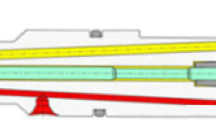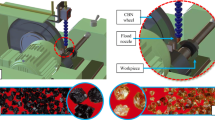Abstract
The extensive tribological use of nodular cast iron in ground transport industry, e.g., trains and automobiles, has brought growing scientific interest. The various applications of this material are due to the versatility of mechanical properties without adding alloy elements, making possible to achieve good results varying just the heat treatment. Due to its high fluidity, workpieces made of this material can be produced with final dimensions and shapes very close to the designed ones, making necessary just the use of finishing machining operations to get the final dimensions, more specifically those concerning the grinding process. To optimize cost production, machining processes became the focus of scientists and engineers. The grinding wheel can determine the success of an operation as its properties influence productivity and workpiece quality decisively. This work analyzes the grinding process of the ductile iron GGG-70 (average hardness of 270 HB) using two types of vitrified bonded CBN grinding wheels, which have as their only distinction the marked difference in friability of the abrasive grains. The performance of each grinding wheel will be analyzed taking into account the output parameters values obtained from surface roughness, average power, diametric wear of the grinding wheel, microstructure of the ground surfaces, and microhardness measures from the ground surface to the center of the workpiece. It was observed that the less friable wheel produced, regarding the average surface roughness, values of 0.27, 0.30, and 0.36 μm for the feed rates of 0.5, 1.0, and 1.5 mm/min, respectively, and, regarding the diametric wheel wear, produced values of 2.52, 2.99, and 4.01 μm for the same feed rates, respectively. On the other hand, when using the more friable wheel, average surface roughness values of 0.33, 0.44, and 0.64 μm and diametric wheel wear values of 3.21, 4.22, and 7.24 μm were obtained. In this way, the less friable wheel showed better results for all the conditions. Considering the feed rate order of 0.5, 1.0, and 1.5 mm/min, the improvement in surface roughness was about 18.18, 31.82, and 43.75%, respectively, and the reduction of the wheel wear was about 21.50, 29.15, and 44.61%.
Similar content being viewed by others
References
Heisel U, Klocke F, Uhlmann E, Spur G (2014) Handbuch Spanen. Carl Hanser Verlag, Print ISBN: 978-3-446-42826-3. p. 14–17
Denkena B, Grove T, Bremer I, Behrens L (2016) Design of bronze-bonded grinding wheel properties. CIRP Ann Manuf Technol 65:333–336
Rowe WB (2014) Principles of modern grinding technology. Elsevier, New York
Linke B (2016) Life cycle and sustainability of abrasive tools. Springer, Switzerland
Novoselov Y, Bratan S, Bogutsky V (2016) Analysis of relation between grinding wheel wear and abrasive grains wear. Procedia Eng 150:809–814
Jackson MJ (2007) Modelling of fracture wear in vitrified cBN grinding wheels. J Achiev Mater Manuf Eng 24:230–236
Jackson MJ, Davim JP (2011) Abrasive tools and bonding systems. Machining with abrasives. Springer Science, New York
Ding W, Zhu Y, Zhang L, Xu J, Fu Y, Liu W, Yang C (2015) Stress characteristics and fracture wear of brazed CBN grains in monolayer grinding wheels. Wear 332-333:800–809
Wu C, Li B, Liu Y, Liang SY (2017) Surface roughness modeling for grinding of silicon carbide ceramics considering co-existence of brittleness and ductility. Int J Mech Sci 133:167–177
Sosa AD, Echeverría MD (2015) Surface alterations produced in grinding of austempered ductile iron. Procedia Mater Sci 8:155–161
Zeng D, Lu L, Zhang N, Gong Y, Zhang J (2017) Influence of a hybrid treatment consisting of fine particle bombardment and powder impact plating on the scuffing behavior of ductile cast iron. Wear 372-373:1–11
Iacoviello F, Cocco VD (2016) Influence of the graphite elements morphology on the fatigue crack propagation mechanisms in a ferritic ductile cast iron. Eng Fract Mech 167:248–258
Bouzakis KD, Bouzakis E, Kombogiannis S, Makrimallakis S, Skordaris G, Michailidis N, Charalampous P, Paraskevopoulou R, M’Saoubi R, Aurich JC, Barthelma F, Biermann D, Denkena B, Dimitrov D, Engin S, Karpuschewski B, Klocke F, O¨ z T, Poulachon G, Rech J, Schulze V, Settineri L, Srivastava A, Wegener K, Uhlmann E, Zeman P (2014) Effect of cutting edge preparation of coated tools on their performance in milling various materials. CIRP J Manuf Sci Technol 7:264–273
Aurich JC, Effgen C, Kirsch B (2016) Cutting edge preparation with elastic bonded superabrasive grinding wheels. CIRP Ann Manuf Technol 65:329–332
Kuffa M, Kuster F, Wegener K (2016) Comparison of lubrication conditions for grinding of mild steel with electroplated cBN wheel. CIRP J Manuf Sci Technol 18:53–59. https://doi.org/10.1016/j.cirpj.2016.09.002
Taborga JDM (2002) Análise e Monitoramento da Retificação do Ferro Fundido Nodular com Rebolos de Nitreto de Boro Cúbico (CBN). Dissertação de Mestrado em Engenharia Mecânica, Universidade Federal de Santa Catarina, Florianópolis, 2002
Silva RS, Corrêa ECS, Brandão JR, Ávila RF (2013) Environmentally friendly manufacturing: behavior analysis of minimum quantity of lubricant - MQL in grinding process. J Clean Prod. https://doi.org/10.1016/j.jclepro.2013.01.033
Taborga ARM, Taborga JDM, Weingaertner WL (2003) Análise da Rugosidade Obtida na Retificação de Ferro Fundido Nodular Utilizando Rebolos de SiC e Al2O3. 2° Congresso Brasileiro de Engenharia de Fabricação (2° COBEF)
Tönshoff HK, Inasaki I (2001) Sensors in manufacturing. Wiley-VCH publisher, Weinheim
Malkin S, Guo C (2008) Grinding technology: theory and application of machining with abrasives
Acknowledgments
The authors thank the Group Saint Gobain Ceramic Materials/Surface Conditioning area for its donation of the CBN abrasive grains and for its support of this research, Nikkon Ferramentas de Corte Ltda for providing the grinding wheels and Quimatic Tapmatic Brazil for the donation of the cutting fluid used in this research.
Funding
This research received financial support from FAPESP and CNPq (Brazil).
Author information
Authors and Affiliations
Corresponding author
Rights and permissions
About this article
Cite this article
de Martini Fernandes, L., Lopes, J.C., Volpato, R.S. et al. Comparative analysis of two CBN grinding wheels performance in nodular cast iron plunge grinding. Int J Adv Manuf Technol 98, 237–249 (2018). https://doi.org/10.1007/s00170-018-2133-4
Received:
Accepted:
Published:
Issue Date:
DOI: https://doi.org/10.1007/s00170-018-2133-4




